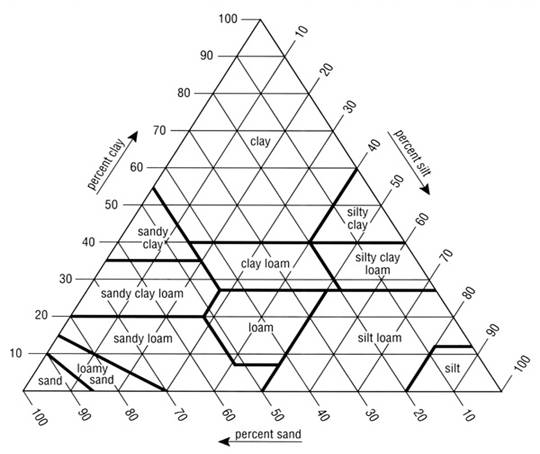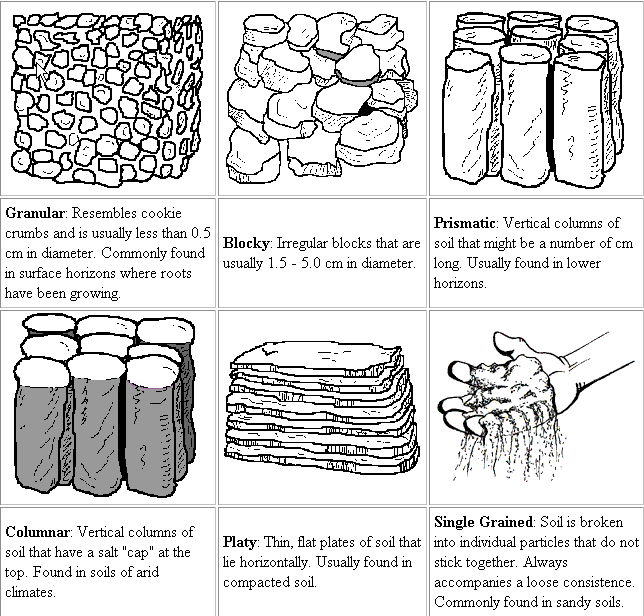
|
|||||
Soil Texture and Soil StructureSoil texture and soil structure are both unique properties of the soil that will have a profound effect on the behavior of soils, such as water holding capacity, nutrient retention and supply, drainage, and nutrient leaching. In soil fertility, coarser soils generally have a lesser ability to hold and retain nutrients than finer soils. However, this ability is reduced as finely-textured soils undergo intense leaching in moist environments. Soil TextureSoil texture has an important role in nutrient management because it influences nutrient retention. For instance, finer textured soils tend to have greater ability to store soil nutrients. In our discussion on soil mineral composition, we mentioned that the mineral particles of a soil are present in a wide range of size. Recall that the fine earth fraction includes all soil particles that are less than 2 mm. Soil particles within this fraction are further divided into the 3 separate size classes, which includes sand, silt, and clay. The size of sand particles range between 2.0 and 0.05 mm; silt, 0.05 mm and 0.002 mm; and clay, less than 0.002 mm. Notice that clay particles may be over one thousand times smaller than sand particles. This difference in size is largely due to the type of parent material and the degree of weathering. Sand particles are generally primary minerals that have not undergone much weathering. On the other hand, clay particles are secondary minerals that are the products of the weathering of primary minerals. As weathering continues, the soil particles break down and become smaller and smaller. Textural TriangleSoil texture is the relative proportions of sand, silt, or clay in a soil. The soil textural class is a grouping of soils based upon these relative proportions. Soils with the finest texture are called clay soils, while soils with the coarsest texture are called sands. However, a soil that has a relatively even mixture of sand, silt, and clay and exhibits the properties from each separate is called a loam. There are different types of loams, based upon which soil separate is most abundantly present. If the percentages of clay, silt, and sand in a soil are known (primarily through laboratory analysis), you may use the textural triangle to determine the texture class of your soil.
The major textural classes for the soils of Maui are provided in Table 3. Each of the textural classes listed in Table 3 make up finely textured soils. As you can see, soil surveys show that more than 90% of Maui’s soils are finely textured. This is largely due to the type of parent material of most Hawaii soils, which is basalt. Since basalt is a finely textured rock, it weathers into finely textured soils. The relative amount of clay has great importance in the soil. Table 3. Major textural classes of Maui soils
To learn more about the textural triangle and textural classifications of soil, click on the North Carolina State University animation below: Importance of Clay and Other Particles of Similar SizeClay particles, as well as other particles of similar size, are important components of a soil. There is a fundamental difference between soils that contain large amounts of sand particles and soils that contain large amounts of very small particles, such as clay. That difference is surface area. The total surface area of a given mass of clay is more than a thousand times the total surface area of sand particles with the same mass. To put this idea into perspective, imagine a single cube with 6 sides. This cube represents a sand particle. Now, imagine that you break this single cube up into 100 smaller cubes, which represent 100 clay particles. These 100 cubes each have 6 sides. Essentially, by breaking up the larger cube, you have exposed many more surfaces. Thus, the total surface area of the smaller cubes will be much greater than the surface area of the single cube. To explore this concept further, view a brief animation by clicking the following link to North Carolina State University: This increase in surface area has an important implication in nutrient management because it provides many places for soil particles to retain and supply nutrients (such as calcium, potassium, magnesium, phosphate) and water for plant uptake Types of Very Small Particles within the Soil
For more details about the various layered silicate clay minerals, click on the link below and scroll down to the “Phyllosilicate Room:”
Properties of oxides
Soil StructureSoil structure is the arrangement of soil particles into groupings. These groupings are called peds or aggregates, which often form distinctive shapes typically found within certain soil horizons. For example, granular soil particles are characteristic of the surface horizon. Soil aggregation is an important indicator of the workability of the soil. Soils that are well aggregated are said to have “good soil tilth.” The various types of soil structures are provided in Table 4. Table 4. Types of Soil Structures in Soils Soil AggregatesGenerally, only the very small particles form aggregates, which includes silicate clays, volcanic ash minerals, organic matter, and oxides. There are various mechanisms of soil aggregation. Mechanisms of soil aggregation
Aggregate StabilityStable soil aggregation is a very valuable property of productive soils. Yet, the stability of soil aggregation is very reliant on the type of minerals present in the soil. Certain clay minerals form very stable aggregates, while other clay minerals form weak aggregates that fall apart very easily.
For a simple discussion of the chemistry of soil clays, click on the following link: To learn more detail about the structure of silicates clays, click on the next link from the University of Florida: | |||||||||||||

